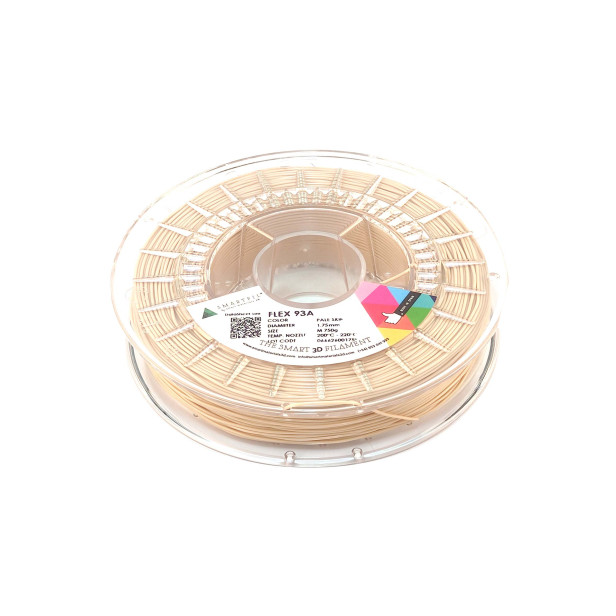Flexible TPU 93A Skin Filament for 3D Printing | Smartfil
Filament 1.75mm red flexible and elastic for 3D printer
330-750g
Te quedan 120€ para el envío gratis

24h Delivery

FREE for orders over 120€

Secure payment
Información del producto
FEATURES – FLEXIBLE SKIN FILAMENT (TPU 93A):
- Material type: Polyurethane (TPU – Thermoplastic Polyurethane)
- Material characteristic: Flexible
- Filament color: Skin tone
- Shade: Pale Skin
- Shade: Medium Skin
- Shade: Tan Skin
- Filament diameter: 1.75 mm
- Density: 1.21 g/cm³ (ISO 1183)
- Printer settings:
- Printing temperature: 210 – 235 °C (Recommended: 225 °C)
- Heated bed temperature: 0 – 100 °C
- Cooling fan: 100%
- Printing speed: 35 mm/s
- Layer height: 0.2 mm
- Mechanical properties:
- Hardness: 93 Shore A (ISO 868)
- Abrasion resistance: 35 mm³ (ISO 4649)
- Tear resistance: 180 N/mm (ISO 34-1 B/b)
- Tensile strength: 40 MPa (ISO 37)
- Elongation at break: 500% (ISO 37)
- Modulus at 100% strain: 9.5 MPa
- Modulus at 300% strain: 19.5 MPa
- Temperature resistance: 105 °C
- Recyclable
- Net weight: 750 g
- Gross weight: 975 g
- Brand: Smartfil
- Manufacturer: Smart Materials 3D
- Country of manufacture: Spain
USE & APPLICATIONS OF SMARTFIL FLEXIBLE 93A TPU:
If you're looking to print flexible parts, this is your filament. The most common 3D printed applications include:
- Footwear
- Automotive parts
- RC components
- Handles and grips
Smartfil Flexible is an elastic TPU-based filament with high resistance to hydrolysis and oxidation. Its Shore A hardness of 93 makes it compatible with most 3D printers. If your printer uses a Bowden extrusion system, verify it can handle flexible materials, as pushing soft filament through the tube can be challenging. Keep in mind:
- Shore A hardness is used for soft elastomers
- Shore D hardness is used for rigid plastics
- A higher Shore value indicates a stiffer material
MANUFACTURER RECOMMENDATIONS:
This material is moisture-sensitive. Store it sealed in a cool, dry place to maintain quality.
- Ensure consistent flow: Printing TPU isn't easy at first. Adjust print settings gradually. Use adhesive spray or glue stick for better bed adhesion.
- Set the right temperature: Each printer is different. Start at 225 °C. Higher temps reduce clogging, but excessive heat may cause poor surface finish.
- Low print speed: Unlike PLA or ABS, TPU should not be printed fast. 35 mm/s is ideal for consistency.
- Layer height: Use 0.2 mm for a good balance of detail and strength.
- Disable retractions if using Bowden extruder to avoid clogs.
Más productos de Smart Materials 3D






















